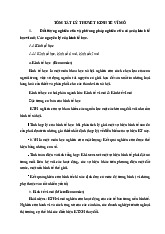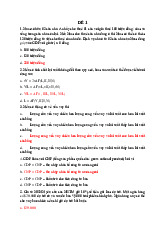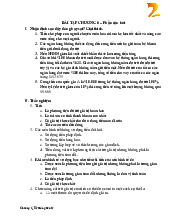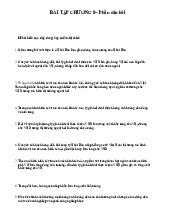

















Preview text:
lOMoARcPSD| 49153326 Marketing Căn bản Chapter1: 1. Definitions :
- “The process of planning and executing the conception, pricing, promotion, and
distribution of ideas, goods, and services to create exchanges that satisfy individual and organizational goals
-“In a business context, marketing is a the process by which companies engage
customers, build strong customer relationships, and create customer value in order to
capture value from customers in return. 2.
• Needs: States of deprivation
- Physical—food, clothing, warmth, safety
- Social—belonging and affection
- Individual—knowledge and self-expression
• Wants : Form that needs take as they are shaped by culture and individual personality
• Demands backed by buying power
3.The marketing process
4. Marketing myopia: thiển cận
– The mistake of paying more attention to the specific products a company
offers than to the benefits and experiences produced by these products.
5. Customer satisfaction: The extent to which a product’s perceived performance
matches a buyer’s expectations.
6. Market : the set of all actual and potential buyers of a product or service. lOMoARcPSD| 49153326 7.MARKETING MANAGEMENT –
Marketing management is the analysis, planning, implementation and
control of programmes designed to bring about desired exchanges with target
markets for the purpose of achieving organizational objectives. –
The aim is to engage, keep, and grow target customers by creating,
delivering, and communicating superior customer value.
MARKETING MANAGEMENT ORIENTATIONS:
a.PRODUCTION concept: Success depends on low production costs, highly
efficient processes, and mass distribution.
+ that consumers will favor products that are available and highly affordable
+ the organization should focus on improving production and distribution efficiency.
b.PRODUCT concept: Success depends on creating the best, most innovative product for the lowest price.
+ consumers will favor products that offer the most quality, performance, and features
+ the organization should devote its energy to making continuous product improvements.
c. SELLING concept: Success depends on a good sales team with the right tools and incentives.
+ consumers will not buy enough of the firm’s products unless the firm
undertakes a large-scale selling and promotion effort.
d. MARKETING concept: Success depends on doing better than competitors at
understanding, creating, delivering, and communicating value to their target customers
e. SOCIETAL MARKETING concept: Marketing decisions should consider
consumers’ wants, the company’s requirements (profits), and society’s long-run interests (human welfare). CHAPTER 2:
1.Marketing environment
-The actors and forces outside marketing that affect marketing management’s
ability to build and maintain successful relationships with target customers Including:
Microenvironment: The actors close to the company that
affect its ability to serve its customers lOMoARcPSD| 49153326 Note:
+ Suppliers: ảnh hướng đến chất lượng,giá, sản phẩm
+ The Company: top management, finance, research and development (R&D), pur-
chasing, operations, human resources, and accounting.
+ Marketing intermediaries: trung gian: help the company promote, sell, and
distribute its products to final buyers. Resellers: đại lí
Physical distribution firms: wholesalers, retailers: resell merchan-dise.
Marketing services agencies (đại lý dịch vụ tt): marketing research firms,
advertising agencies, media firms, and marketing consulting firms Financial
intermediaries ( trung gian tài chính): banks, credit companies, insurance companies,
Resellers are distribution channel firms that help the company find customers or make sales
to them. These include wholesalers and
retailers that buy and resell merchandise.
Physical distribution firms help the company stock and move goods from their points of origin to their destinations.
Marketing services agencies are the marketing research firms, advertising agencies, media
firms, and marketing consulting firms that
help the company target and promote its
products to the right markets.
Financial intermediaries include banks, credit companies, insurance companies, and other
businesses that help finance transactions or
insure against the risks associated with the buying and selling of goods
+Public: Any group that has an actual or potential interest in or impact on
an organization’s ability to achieve its objective: • Financial publics • Media publics. • Government publics. • Citizen-action publics. • Internal publics. • General public. • Local publics. lOMoARcPSD| 49153326 Macroenvironment
Demography ( nhân khẩu): The study of human populations in terms
of size, density, location, age, gender, race, occupation, and other statistics.
Economic factors that affect consumer purchasing power and spending patterns.
Natural environment: The physical environment and the natural resources that are
needed as inputs by marketers or that are affected by marketing activities.
Technological environment: Forces that create new technologies, creating new
product and market opportunities.
Political environment: Laws, government agencies, and pressure groups that
influence and limit various organizations and individuals in a given society.
Cultural environment: Institutions and other forces that affect society’s basic
values, perceptions, preferences, and behaviors. 2.
Marketing information system – MIS and marketing research f.
Marketing research The systematic design, collection, analysis, and reporting
of data relevant to a specific marketing situation facing an organization. lOMoARcPSD| 49153326
Observational research Gathering primary data by observing relevant people, actions, and situations
Survey research Gathering primary data by asking people questions about their
knowledge, attitudes, preferences, and buying behavior.
experimental research Gathering primary data by selecting matched groups of
subjects, giving them different treatments, controlling related factors, and
checking for differences in group responses.
Co ntact Methods Information can be collected by mail, by telephone, by
personal interview, or online. Each contact method has its own particular strengths and weaknesses
Sa mple A segment of the population selected for marketing research to
represent the population as a whole lOMoARcPSD| 49153326
CHAPTER3: CONSUMER BEHAVIOR a. Cultural
-Culture The set of basic values, perceptions, wants, and behaviors learned by a
member of society from family and other important institutions.
Culture is the most basic cause of a person’s wants and behavior.
- Subculture A group of people with shared value systems based on common life
experiences and situations. ( nationality, race, Geographical, Age, region, Gender, Social class) lOMoARcPSD| 49153326
- Social class Relatively permanent and ordered divisions in a society whose
members share similar values, interests, and behaviors. b. Social factors - Social network - Family lOMoARcPSD| 49153326 d. Psychological factors
- Motive (Drive) A need that is sufficiently pressing to direct the person to
seek satisfaction of the need. lOMoARcPSD| 49153326
- Learning: Changes in an individual’s behavior arising from experience.
- Belief: A descriptive thought that a person holds about something.
- Attitude: A person’s consistently favorable or unfavorable evaluations, feelings, and
tendencies toward an object or idea.
a. Complex buying behavior : Consumer buying behavior in situations
characterized by high consumer involvement in a purchase and significant
perceived differences among brands.
b. Dissonance-reducing buying Behavior : Consumer buying behavior in
situations characterized by high involvement but few perceived differences among brands.
c. habitual buying behavior : Consumer buying behavior in situations
characterized by low consumer involvement and few significant perceived brand differences.
d. Variety-seeking buying behavior : Consumer buying behavior in situations
characterized by low consumer involvement but significant perceived brand differences. lOMoARcPSD| 49153326 lOMoARcPSD| 49153326 lOMoARcPSD| 49153326 CHAPTER 4: CHAPTER 2: CHAPTER 7:
1. Xây dựng chiến lược M mục tiêu: lOMoARcPSD| 49153326 lOMoARcPSD| 49153326 Market segmentation
Dividing a market into distinct groups of buyers who have different needs,
characteristics, or behaviors and who might require separate marketing strategies or mixes. lOMoARcPSD| 49153326 Market targeting
Evaluate the various segments and decide how many and which segments the company can serve best.
Undifferentiated marketing (or mass marketing)
A market-coverage strategy in which a firm decides to ignore market segment
differences and go after the whole market with one offer.
Differentiated marketing (or segmented marketing)
A market-coverage strategy in which a firm targets several market segments and
designs separate offers for each.
Concentrated marketing (or niche marketing)
A market-coverage strategy in which a firm goes after a large share of one or a few segments or niches. lOMoARcPSD| 49153326 Micromarketing
Tailoring products and marketing programs to the needs and wants of specific
individuals and local customer segments; it includes: • local marketing • individual marketing
DIFFERENTIATION & POSITIONING
Differentiation: The process companies use to make a product or service stand out
from its competitors in ways that provide unique value to the customer.
Product position: The way a product is defined by consumers on important
attributes—the place the product occupies in consumers’ minds relative to competing products lOMoARcPSD| 49153326 lOMoARcPSD| 49153326 Hhhhhhhhhhhhdhdh




